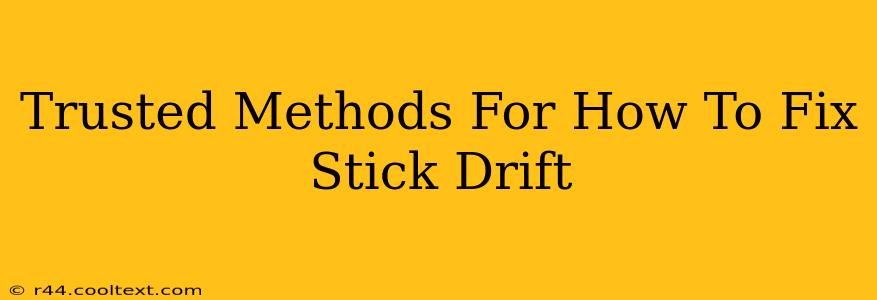Stick drift, that frustrating phenomenon where your controller's joystick registers movement even when it's untouched, can ruin a gaming session. Fortunately, there are several methods you can try to fix this annoying problem. This guide outlines trusted methods, ranging from simple troubleshooting steps to more involved solutions.
Understanding Stick Drift
Before diving into solutions, it's helpful to understand why stick drift happens. It's usually caused by wear and tear on the potentiometer (a component that measures the joystick's position) within your controller. Dust, debris, or even just the natural aging of the component can lead to inaccurate readings, resulting in that unwanted movement.
Troubleshooting Steps: The Easy Fixes
Let's start with the simplest solutions. These often work, saving you the hassle of more advanced repairs.
1. Cleaning Your Controller: The First Line of Defense
The most common cause of stick drift is dirt and debris accumulating around the joystick. A thorough cleaning can often resolve the issue.
- What you'll need: Compressed air, isopropyl alcohol (70% or higher), cotton swabs, and a soft cloth.
- How to do it:
- Power off your controller: This is crucial to prevent accidental damage.
- Use compressed air: Gently blow compressed air around the joystick and its surrounding area to remove loose debris.
- Apply isopropyl alcohol: Dab a cotton swab with a small amount of isopropyl alcohol and carefully clean the joystick and its housing. Avoid getting alcohol inside the controller.
- Dry thoroughly: Let the controller air dry completely before testing.
2. Recalibrating Your Controller: A Software Solution
Many gaming consoles and PCs allow you to recalibrate your controller. This can sometimes correct minor stick drift issues. Consult your console's or PC's instructions for specific recalibration steps. This is often found within the system settings or controller settings menu.
3. Checking for Software Conflicts: Unexpected Interferences
Sometimes, software conflicts can interfere with controller functionality. Try closing unnecessary background applications and restarting your console or PC to see if this helps.
More Advanced Solutions: When Simple Fixes Fail
If the above steps don't solve the problem, you might need to resort to more involved solutions.
4. Disassembling and Cleaning the Joystick: A Deeper Clean
If cleaning the exterior didn't work, you might need to disassemble the joystick itself. This is a more advanced step and requires careful attention to detail. If you're uncomfortable disassembling electronics, skip this and move to the next section. Numerous online tutorials specifically for your controller model can guide you through this process. Remember to use the same cleaning materials mentioned earlier (compressed air and isopropyl alcohol).
5. Controller Repair or Replacement: The Last Resort
If all else fails, your controller might require professional repair or replacement. Contact the manufacturer's support or consider purchasing a new controller. The cost of repair might not be worth it compared to buying a new one, depending on the controller's age and value.
Preventing Stick Drift: Proactive Measures
Preventing stick drift is easier than fixing it. Here are some preventative measures:
- Regular Cleaning: Regularly clean your controller to prevent debris buildup.
- Proper Handling: Handle your controller carefully to avoid excessive wear and tear.
- Protective Cases: Consider using a protective case to shield your controller from dust and damage.
By following these methods, you should be well-equipped to tackle stick drift and get back to enjoying your games. Remember to choose the solution that best fits your comfort level and technical skills. Good luck!

